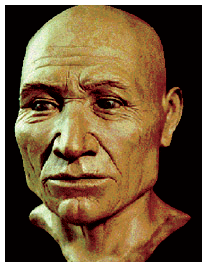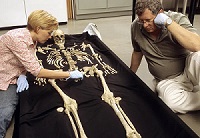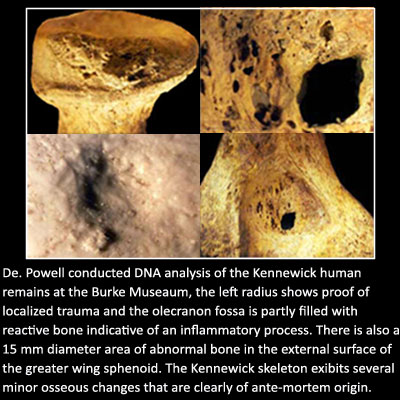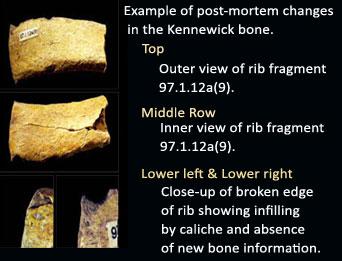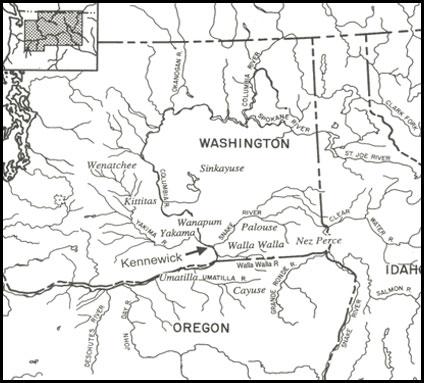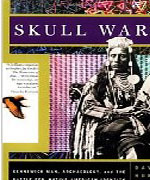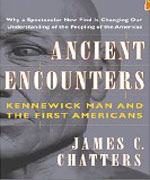- Latest Archaeology Updates
- Importance and applicability
- Famous Archaeologists
- Museums Collections
- Site Map
- World Heritage Sites
- World History Monuments
- Archaeological Organizations
- World Atlas of Archaeology
- Forensic Investigation and Geophysics
- Contact Us
- Movies based on Archaeology
- Frequently Asked Questions
- Archaeological discoveries
- Tell a Friend
- Archaeological Abbreviations
- Gallery Collections
- Famous-Museums site map
- Famous-archaeologists site map
- Archaeological Monuments site map
Kennewick Man is the name given to the skeletal remains of a prehistoric man discovered in Washington State in July 1996. The remains were found by two students who were wading in the shallow waters of the Columbia River. The remains were examined and found to be those of an adult male, likely between the ages of 40 and 55 when he died. Carbon dating of the bones showed that Kennewick Man lived sometime between 8,400 and 9,200 years ago.
The discovery of Kennewick Man sparked a legal and scientific controversy. The US Army Corps of Engineers, who owned the land where the skeleton was found, claimed that the remains were Native American and, as such, subject to the Native American Graves Protection and Repatriation Act (NAGPRA). This act requires that Native American remains be repatriated to the tribe that claims cultural affiliation with the remains.
However, scientists argued that the bones showed features that appeared more closely related to those of Polynesian and Asian peoples, rather than Native American peoples. After a legal battle, the 9th Circuit Court of Appeals granted scientists access to the bones so that they could conduct further analyses.
In the years since its discovery, Kennewick Man has become an important part of the study of human origins and migration. The remains have been studied extensively and have provided insight into the history of the Pacific Northwest and the people who lived there thousands of years ago.
- The mystery of Kennewick Man, a 9,000-year-old skeleton found in Washington state in 1996, has been solved. The skeleton, which is believed to be the oldest and most complete human remains ever discovered in North America, has finally been identified as belonging to a Native American man.
- The skeleton was discovered near Kennewick, in the Columbia River Basin, by two college students who were out walking along the river. The remains were taken to the Burke Museum of Natural History and Culture in Seattle and subjected to numerous tests, including carbon dating and DNA analysis, to determine the age and identity of the individual.
- In 2015, the U.S. Army Corps of Engineers, who own the land where the skeleton was found, allowed the remains to be studied by a team of scientists from around the world. After months of research, the scientists determined that the remains belonged to an ancient Native American man who lived more than 9,000 years ago.
- The team also concluded that the man was most likely of the ancient Chinookan people, a group of Native American tribes who lived in the Columbia River Basin. The scientists were able to make this conclusion based on the similarity of the skull and facial features to other ancient Native American remains found in the area.
- The discovery of Kennewick Man has finally put to rest the mystery of his identity and origins. It is a major breakthrough in the field of anthropology, as it sheds light on the history of the early inhabitants of North America.
- The discovery of the ancient skeletal remains of Kennewick Man in 1996 sparked a scientific and cultural revolution that has been ongoing for over two decades.
- The remains were discovered in the Columbia River, near Kennewick, Washington, and are believed to be at least 8,500 to 9,000 years old.
- The discovery of the remains and their subsequent analysis has caused a major debate between Native American tribes and scientists as to who the remains belong to and what should be done with them.
- The scientific analysis of the remains revealed a number of features which were not typical of Native American tribes in the area.
- The skull shape, for example, is distinctly different from that of any modern Native American populations. In addition, the genetic analysis of the remains showed that Kennewick Man was more closely related to Asian and Polynesian populations than modern Native American tribes in the area.
- The discovery of the ancient remains of Kennewick Man sparked a series of legal battles as to who should control and possess the remains.
- Native American tribes argued that they should be able to take possession of the remains and bury them according to their own cultural beliefs.
- Scientists argued that the remains should be studied and preserved for future generations. The case was eventually settled in 2017 when the U.S. Army Corps of Engineers allowed the Native American tribes to take possession of the remains and rebury them.
- The discovery and ongoing debate surrounding the ancient remains of Kennewick Man has been a major event in the scientific and cultural world.
- It has highlighted the importance of respecting the beliefs and traditions of Native American tribes, as well as the need for scientific research and preservation. As such, the discovery of Kennewick Man has been an important milestone in the history of science and culture.
The Kennewick Man argument is a legal dispute over the remains of a 9,000-year-old human skeleton discovered in Kennewick, Washington, in 1996. The remains were initially believed to be Native American, and various tribes claimed the skeleton as part of their ancestral heritage. In 2004, the U.S. Army Corps of Engineers declared the remains to be culturally unaffiliated, and thus not Native American. This opened the door for a suite of scientific research which proved the remains to be a unique population not closely related to any living Native American population.
This sparked a legal debate between scientists, Native American tribes, and the U.S. government over who had the right to study and own the remains. After a lengthy court process, the U.S. Department of the Interior declared the remains to be culturally unaffiliated in 2015, granting scientists the right to study them. The tribes still maintain their claim to the remains, but the courts have ruled that they have no legal standing to prevent the scientific study.
The Kennewick Man is an ancient human skeleton discovered in Kennewick, Washington, in 1996. The discovery of this 9,000-year-old skeleton has sparked a long-running debate about the origin and identity of the Kennewick Man. This debate has implications for the scientific, religious, and political arenas.
-
Science :Scientifically, the Kennewick Man has been studied extensively since its discovery. The skeleton has allowed scientists to gain a better understanding of the physical characteristics of ancient human populations in the region. The skeletal remains have also been used to study how early Native Americans adapted to their environment and what their diet was like. Additionally, the discovery of the skeleton has enabled scientists to trace the genetic origins of the ancient population in the region.
-
Religion :Religiously, the Kennewick Man has become a source of debate for many Native American tribes. Tribes in the Pacific Northwest, including the Umatilla, Yakama, and Nez Perce, have argued that the skeleton is an ancestor and should be treated with respect and reburied in accordance with their religious beliefs. Other tribal groups, such as the Colville and Spokane, have argued that the Kennewick Man is not an ancestor and should not be treated as such.
-
Politics :Politically, the debate surrounding the Kennewick Man has also been heavily contested. In 2000, the U.S. Army Corps of Engineers declared the skeleton to be culturally affiliated with the Umatilla and other Native American tribes, thus granting them control over the remains. However, this decision was challenged in court by a group of scientists and anthropologists. In 2004, the court ruled in favor of the scientists, allowing them to continue their studies of the Kennewick Man. The political implications of the ruling are still being felt today, as the court's decision has caused tension between Native American tribes and the scientific community.
A Window into Prehistoric Life: The Story of the Kennewick Man
- The Kennewick Man is the name given to a remarkably well-preserved ancient skeleton discovered in the Columbia River in Kennewick, Washington, in 1996.
- The remains were found to be over 8,400 years old, making them among the oldest human remains ever discovered in North America. Upon its discovery, the skeleton quickly became the subject of intense scientific and legal debate as to who had the right to decide how the remains would be treated and studied.
- The discovery of the Kennewick Man was made when two men spotted something sticking out of the sediment near the banks of the Columbia River. Upon closer inspection, they realized that it was the remains of a human skeleton.
- The remains were surrounded by a number of artifacts, including a spear point, which suggested that the man had been a hunter.
- The skeleton was sent to the University of Washington for analysis, where anthropologists determined that the Kennewick Man was approximately 9,000 years old. This made him one of the oldest skeletons ever discovered in North America. Scientists were also able to determine that the Kennewick Man was a tall, muscular male between the ages of 40 and 55.
- In the years that followed, scientists were determined to learn as much as possible about the Kennewick Man and his life.
- Through radiocarbon dating and other methods, they were able to determine that the man was a hunter-gatherer who lived an active lifestyle. He ate a variety of foods, including salmon, deer, and small mammals. He was also a skilled tool maker, and his tools indicated that he had contact with people from other regions.
- The Kennewick Man was a fascinating discovery, it quickly became embroiled in controversy. Several Native American tribes claimed the remains as their ancestor and wanted to give him a traditional burial.
- Scientists argued that studying the Kennewick Man could reveal important information about the lives of prehistoric people.
- After a lengthy legal battle, the U.S. Army Corps of Engineers, who owned the land where the remains were found, allowed a team of scientists to study the Kennewick Man. The results of the study were published in 2014, providing a fascinating window into the life of a prehistoric man. From his remains, scientists were able to learn about the diet of ancient people and how they interacted with the environment.
- The Kennewick Man remains an important part of our understanding of prehistoric life. His discovery has helped to shed light on the lives of our ancient ancestors and has provided us with a unique glimpse into the distant past.
Post-Recovery Changes Of Knennewick Men
The Kennewick Man has made a remarkable recovery since his discovery in 1996. He has been re-examined by the scientific community and is now considered to be one of the oldest and most complete skeletons of its kind. Scientists have been able to learn a great deal about the man and his life from his remains.
One of the most significant changes that have been made to the Kennewick Man is the establishment of a formal identity. Scientists were able to use DNA testing to determine that he was related to modern Native American tribes. This has enabled the tribes to finally have a cultural connection to this ancient man. As a result, the Kennewick Man has been given the name "Ancient One" and is recognized as an ancestor of the Native American tribes.
To establishing a cultural identity, scientists have also been able to learn a great deal about the physical characteristics of the man. They have determined that he was approximately 8,500 years old, and that he had a robust physique and stood around 5 feet 9 inches tall. He also had a number of physical characteristics that are unique to Native Americans, including a broad face, high cheekbones, and shovel-shaped incisors.
The Kennewick Man has now been given a proper burial. In 2017, the U.S. Army Corps of Engineers, which held the remains, agreed to return them to the five Native American tribes that are related to him. They held a traditional burial ceremony and the remains were laid to rest in a private location. This gave the man the proper burial that he deserved, and provided closure to the Native American tribes that had a connection to him.
Books Related to Kennewick Man
KENNEWICK MAN, ARCHAEOLOGY, AND THE BATTLE FOR NATIVE AMERICAN IDENTITY written by PETER N. NEVRAUMONT
Anyone trying to make sense of the flap over Kennewick Man--the touchstone of this book--will be frustrated by the lack of solid scientific description.
The skeleton known as Kennewick Man was discovered in 1996 by two young men along the Columbia River near Kennewick, Washington.
Amesbury Archer (or King of Stonehenge) is an early Bronze Age man, dating to around 2300 BC. His grave is of particular importance because of the rich valuables and the earliest gold objects ever found in England.
Otzi the Iceman is well naturally preserved mummy of a man. The man who was been captured in Ice was believed to be over 53 centuries old (3300 BC).
Java man is an interesting discovery to note that the find was not a complete specimen, but consisted merely of a skullcap, a femur, and three teeth. Many scientists of the day even suggested that Dubois' Java Man might have been the so-called "missing link
Kennewick Man is the name for the remains of a prehistoric man found on a bank of the Columbia River near Kennewick, Washington, on July 28, 1996. The Kennewick Man news story is one of the most significant archaeology stories of contemporary times.
Neandertal1 or Neanderthal was a species of genus Homo (Homo neanderthalensis) that inhabited Europe and parts of western Asia during the last ice age.
Peking Man (sometimes now called Beijing Man), also called Sinanthropus pekinensis (currently Homo erectus pekinensis), is an example of Homo erectus.
The Red Lady of Paviland is a fairly complete Upper Paleolithic-era human male skeleton dyed in red ochre, discovered in 1823 by Rev. William Buckland in one of the Paviland limestone caves of the Gower Peninsula in south Wales, dating from c29,000.
The Tollund man lived during the late 5th century BC and/or early 4th century BC, about 2,400 years . He was buried in a peat bog on the Jutland Peninsula in Denmark, a find known as a bog body.
Turkana Boy, the designation given to fossil KNM-WT (Kenya National Museum-West Turkana), is a nearly complete skeleton of a 12-year-old hominid boy who died 1.6 million years ago.Turkana Boy is classified as either Homo erectus or Homo ergaster.
The Dead Sea Scrolls are a collection of about 850 documents, including texts from the Hebrew Bible, which were discovered in eleven caves near Qumran, in a fortress northwest of the Dead Sea in Israel.
The Narmer Palette, or Great Hierakonpolis Palette, is a significant Egyptian archeological find, dating from about 3200 BC, containing some of the earliest hieroglyphic inscriptions ever found, and depicting the unification of Upper and Lower Egypt under Narmer.
Rosetta Stone is a dark granite stone (often incorrectly identified as "basalt") which provided modern researchers with translations of ancient text in Egyptian demotic script, Greek, and Egyptian hieroglyphics.
Linear B is the script that was used for writing Mycenaean, an early form of the Greek language. It occurrs primarily on tablets dated from the 14th and 13th centuries BC.
The Sweet Track is an ancient roadway in the Somerset Levels, England. As of the early 2000s, it is the oldest known engineered roadway in the world. An grand footpath that ran for almost 2km across the Somerset levels swamps.
Tautavel Man is an ancestor of Neanderthal man, was slightly different from his contemporaries living Asia and Africa. In the village of Tautavel is located in the South of France, one of the most ancient humans was found: the Tautavel Man.
The Galilee Boat which is also referred as the "Jesus Boat" was found by local Galilean inhabitants in January 1986. The boat was wrapped in a polyurethane shell and then immersed in a special tank of water to avoid quick disintegration.
The monumental Ekron inscription is dated, statistically and historically, to the first half of the seventh century B.C.E. The five lines of the inscription are together with this in a slit open border.
It wasn't long back when a lot of scholars were quizzical the real survival of a Roman Governor with the name Pontius Pilate, the procurator who ordered Jesus' crucifixion. In June 1961 close to Caesarea-on-the-Sea (Maritima) was unearthed this appealing limestone block.
In 1990 ornately decorate limestone ossuary (bone depository) was found in Jerusalem's Peace Forest. In the ossuary were the bones of two babies, a adolescent child, a teenage boy, an adult woman, and a man about 60years of age.
In biblical Israel, papyrus was the main form of writing substance. Once an authorized deed was written, it would be rolled up, one end crinkled in one-third of the width and the contrary end likewise folded in.
It is the Capital city of a prehistoric principality in what these days is on the northern part of the Syrian coast, just north of the city of Latakia.

